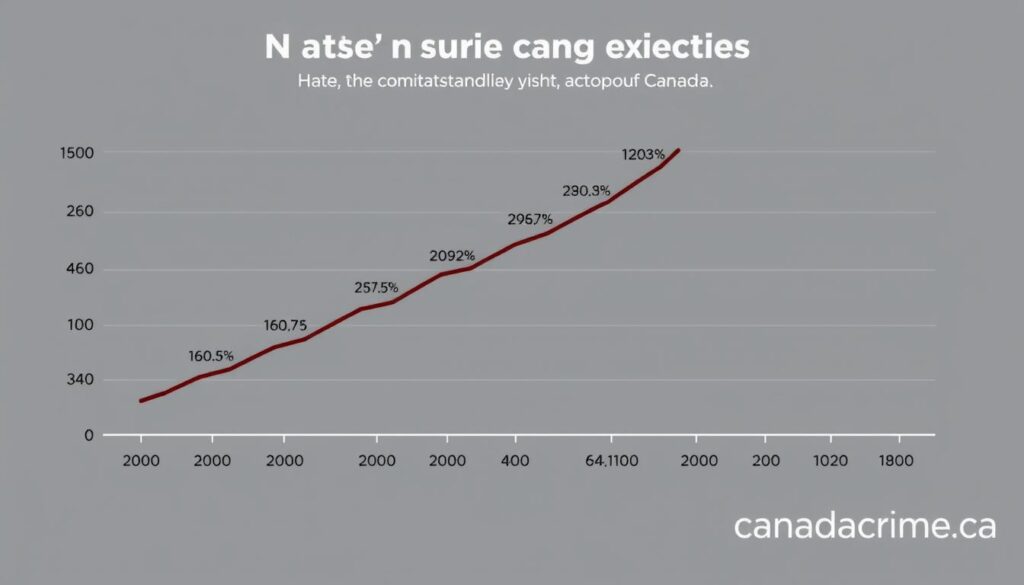Canada saw 3,576 police-documented hate crimes in 2022. This marks a 27% rise from pre-pandemic levels. These numbers show why grasping hate crime laws is crucial for Canadians.
The Canadian Criminal Code has rules for bias-motivated offenses. These laws protect vulnerable groups from discrimination. They also set serious penalties for offenders.
This guide explains how Canadian law defines hate crimes. It shows which groups are protected. You’ll learn about recent efforts like Canada’s Anti-Racism Strategy (2019-2022).
You’ll discover how to spot and report hate incidents. This knowledge can help you stay safe. It can also aid in creating more welcoming communities.
What Constitutes a Hate Crime in Canada
Hate crimes in Canada have specific legal definitions and distinctions within the justice system. The legal framework has important nuances that affect how these offenses are handled. Let’s explore what makes an act a hate crime in Canada.
Legal Definition Under the Canadian Criminal Code
The Canadian Criminal Code doesn’t have a specific “hate crime” offense. Instead, hate is an aggravating factor in sentencing for any criminal offense. This means harsher penalties for crimes motivated by bias or prejudice.
The Uniform Crime Reporting Survey (UCR) Manual defines hate crimes clearly. It’s a criminal act motivated by hate based on various factors. These include race, religion, sexual orientation, and other protected characteristics.
The Criminal Code has specific hate propaganda offenses. These target hate speech that threatens identifiable groups. Sections 318 and 319 address advocating genocide and inciting public hatred.
Law enforcement agencies use the UCR definition nationwide. This helps track patterns and trends in bias-motivated violence across Canada. It ensures consistent identification and data collection of hate-motivated offenses.
Difference Between Hate Crimes and Hate Incidents
Not all hateful actions are crimes under Canadian law. Hate crimes must involve a Criminal Code violation plus bias motivation. Without both elements, it’s classified as a hate incident.
Hate incidents are harmful but don’t meet criminal prosecution standards. These might include discriminatory comments or offensive symbols. They cause harm but don’t qualify as criminal offenses.
| Characteristic | Hate Crime | Hate Incident | Response Mechanism |
|---|---|---|---|
| Legal Status | Criminal offense | Non-criminal | Different legal pathways |
| Required Elements | Criminal act + bias motivation | Bias-motivated behavior only | Different evidentiary standards |
| Potential Consequences | Criminal charges, enhanced sentencing | No criminal penalties | Different remedies available |
| Reporting Channel | Police services | Human rights commissions, community organizations | Different reporting processes |
Knowing this difference helps you choose the right action. For hate crimes, contact law enforcement. For hate incidents, consider human rights complaints or community intervention. Both can harm individuals and communities significantly.
Hate crimes are message crimes. They are different from other crimes in that the offender is sending a message to members of a certain group that they are unwelcome.
The Evolution of Hate Crime Legislation in Canada
Canada’s hate crime laws have grown stronger over time. These laws protect vulnerable communities from bias-motivated offenses. They reflect Canada’s recognition that racism and discrimination need specific legal remedies.
This legislation has been shaped by changing social attitudes. Landmark court decisions have also played a role. Canada’s commitment to multiculturalism has been a key factor.
Historical Development of Anti-Hate Laws
Canada’s fight against hate began taking shape in the early 1970s. In 1971, multiculturalism became an official federal policy. This policy recognized the value of diversity in Canadian society.
It was an important step in protecting civil rights based on cultural identity. The 1988 Canadian Multiculturalism Act was a crucial advancement.
This law formalized Canada’s commitment to preserving and enhancing multiculturalism. It aimed to eliminate systemic barriers faced by minority communities. The Act created a legal framework for future hate crime provisions.

Early hate speech laws in the Criminal Code faced constitutional challenges. These challenges helped balance free expression and protection from hatred. Court battles shaped Canada’s approach to hate-motivated offenses.
They established important precedents that still influence legal interpretations today.
Recent Amendments and Updates to Canadian Legislation
In 1995, Parliament amended the Criminal Code to recognize hate as an aggravating factor in sentencing. This change meant judges must consider bias-motivated offenses when determining sentences.
In 2017, Canada added “gender identity or expression” to hate crime protections. This amendment recognized the violence and discrimination faced by transgender and gender-diverse Canadians.
Recent years have seen growing attention to online hate. Canadian courts now recognize that digital hate falls under existing prohibitions. Hate crime legislation continues to evolve to address new forms of discrimination.
Key Sections of the Canadian Criminal Code Addressing Hate Crimes
The Canadian Criminal Code has specific provisions to combat hate crimes. These laws work together to prosecute hate crimes and protect vulnerable communities. They create a comprehensive approach to fighting extremism and bigotry.
Advocating Genocide
Section 318 criminalizes advocating or promoting genocide against an identifiable group. It’s one of the most serious hate-related offenses in Canadian law. Under this section, genocide refers to acts intended to destroy an identifiable group.
- Killing members of the group
- Deliberately inflicting conditions calculated to bring about physical destruction
- Imposing measures intended to prevent births within the group
Conviction under Section 318 carries a maximum penalty of five years imprisonment. This reflects the severity of such extreme bigotry. Prosecutions are rare but significant, requiring the Attorney General’s consent.
Public Incitement of Hatred

Section 319 addresses two distinct offenses related to hate speech. Subsection 319(1) targets public statements that could provoke immediate violence against an identifiable group. It criminalizes public incitement of hatred likely to lead to a breach of peace.
Subsection 319(2) prohibits willfully promoting hatred against any identifiable group in public. Subsection 319(2.1) specifically addresses willfully promoting antisemitism by denying or downplaying the Holocaust. These provisions include defenses like true statements, religious expression, and public interest discussions.
Mischief Relating to Religious Property
Section 430(4.1) addresses hate-motivated mischief targeting properties used by identifiable groups. This includes religious buildings, schools, and community centers. It covers vandalism, property damage, and desecration motivated by bias or prejudice.
Offenses under this section carry enhanced penalties compared to regular mischief charges. Maximum sentences range from ten years to life imprisonment, depending on the damage’s nature and consequences.
Sentencing Provisions Under Section 718.2
Section 718.2(a)(i) makes hate motivation an aggravating factor in sentencing for any criminal offense. Courts must impose more severe sentences when crimes are motivated by bias, prejudice, or hate.
This provision allows any crime to be treated as a hate crime when motivation is proven. It gives judges flexibility to address extremism across all criminal offenses, even when specific hate crime provisions don’t apply.
Protected Groups Under Canadian Hate Crime Laws
Canadian hate crime laws protect specific groups at risk of targeted violence. These protections reflect Canada’s commitment to safeguarding its diverse population. The laws address historical discrimination patterns and risks from xenophobia and organized hate groups.

Identifiable Groups Defined by Federal Law
The Criminal Code of Canada defines “identifiable group” in subsection 318(4). It includes sections of the public distinguished by specific characteristics.
Protected characteristics include race, color, national or ethnic origin, religion, age, and sex. Sexual orientation, gender identity or expression, mental or physical disability, and language are also protected.
This definition has expanded over time. Gender identity and expression were added to federal hate crime protections in 2017.
Provincial Human Rights Protections
Provincial and territorial human rights codes often provide additional safeguards. These codes create a patchwork of protections that may exceed federal standards in some areas.
| Province | Additional Protected Grounds | Reporting Mechanism | Unique Features |
|---|---|---|---|
| Ontario | Family status, marital status | Human Rights Tribunal of Ontario | Specific protections for gender expression |
| Quebec | Political convictions, social condition | Commission des droits de la personne | Language protections (French) |
| British Columbia | Family status, political belief | BC Human Rights Tribunal | Expanded definition of disability |
| Alberta | Family status, source of income | Alberta Human Rights Commission | Religious freedom emphasis |
Expanding Protections for Vulnerable Communities
Advocacy efforts push for expanded protections for additional vulnerable communities. This is crucial given Canada’s diverse demographic makeup. As of 2021, 26% of Canadians identify as visible minorities.
The 2SLGBTQI+ community has seen significant legal advances in recent years. However, new forms of xenophobia and hate groups continue to target vulnerable populations.
Current advocacy focuses on addressing gaps in protection for intersectional identities. Some communities face discrimination based on several factors at once. This makes comprehensive protections essential for these overlapping identities.
Hate Crime Statistics and Trends in Canada
Hate crimes in Canada have increased alarmingly in recent years. This affects various groups and regions across the country. Understanding these trends is vital for creating effective prevention strategies and support systems.
Statistical evidence sheds light on the nature and frequency of hate crimes throughout Canada. This data is crucial for developing targeted solutions to combat this growing problem.
Recent Data from Statistics Canada
Statistics Canada reports a troubling rise in hate crime incidents nationwide. 2021 marked the third consecutive year of increases in reported hate crimes. A sharp 72% spike occurred between 2020 and 2021 alone.
This surge follows a pattern of steady increases since data tracking began. The numbers indicate a persistent and growing problem requiring urgent attention from various sectors.

Most Targeted Groups in Canadian Communities
Hate crimes motivated by religion saw a 67% increase in 2021. Jewish and Muslim communities have been particularly affected by this surge. Incidents based on race or ethnicity increased by 6% during the same period.
Black, Asian, and Indigenous communities face disproportionate targeting. Crimes against sexual orientation remain high, highlighting the vulnerability of LGBTQ+ Canadians.
| Motivation Category | Percentage Increase (2020-2021) | Most Affected Groups | Common Incident Types |
|---|---|---|---|
| Religion | 67% | Jewish, Muslim communities | Property damage, harassment, threats |
| Race/Ethnicity | 6% | Black, Asian, Indigenous peoples | Verbal attacks, physical assault, vandalism |
| Sexual Orientation | 25% | LGBTQ+ individuals | Assault, harassment, online threats |
| Gender Identity | 18% | Transgender individuals | Verbal abuse, physical violence, discrimination |
Geographic Distribution Across Provinces and Territories
Hate crimes are not evenly distributed across Canada. All provinces and territories except Yukon reported increased numbers in 2021. Urban centers typically record higher absolute numbers of incidents.
Ontario and Quebec have seen the largest numerical increases. Some provinces have experienced higher percentage increases from previously lower baselines. These patterns may reflect actual incident rates and differences in reporting mechanisms.
Reporting Gaps and Challenges
Experts agree that official numbers underrepresent the true scope of hate crimes and racism in Canada. Many incidents go unreported for various reasons. This creates substantial gaps in our understanding of the problem.
Fear of retaliation prevents many victims from coming forward. This is especially true in smaller communities where anonymity is difficult. Distrust of law enforcement also contributes to underreporting.
Language barriers hinder newcomers from reporting hate incidents. Many potential victims are unaware of what constitutes a hate crime or how to report one. This highlights the need for greater public education on this issue.
How to Identify Potential Hate Crimes in Your Community
Recognizing potential hate crimes in your area can help protect vulnerable community members. Hate incidents have spiked during the COVID-19 pandemic. Many minorities now feel unsafe in their own neighborhoods.
Learning to spot warning signs and understanding illegal hate speech can create safer spaces. Your vigilance can make a real difference in your community’s safety.

Common Indicators and Warning Signs
Hate crimes often show warning signs before they happen. Being alert to certain indicators can help prevent escalation. These signs may appear in public spaces, community events, or everyday conversations.
Physical indicators include vandalism with specific symbols, targeted property damage, or threatening graffiti. Look for hate group symbols on walls, posters, or flyers in your area.
Verbal cues often come before physical hate crimes. Listen for language that dehumanizes groups or uses slurs. Watch for rhetoric blaming societal problems on specific communities.
Behavioral patterns can also signal potential hate crimes. Notice if individuals harass certain community members or distribute hateful materials. Be aware of events that explicitly target protected groups.
| Warning Sign Category | Specific Indicators | Potential Severity | Recommended Action |
|---|---|---|---|
| Physical | Hate symbols, targeted vandalism, intimidating graffiti | Medium to High | Document with photos, report to police |
| Verbal | Slurs, dehumanizing language, threats | Low to High | Record details, report if threatening |
| Behavioral | Stalking, harassment, intimidation | Medium to High | Report to authorities, support victims |
| Organizational | Hate group meetings, recruitment efforts | High | Alert community leaders and police |
Distinguishing Between Free Speech and Hate Speech in Canadian Context
Knowing the difference between free expression and illegal hate speech is crucial. The Canadian Charter protects freedom of expression, but this right has limits.
In Canada, hate speech becomes illegal when it publicly incites hatred against an identifiable group. This includes promoting genocide or willfully spreading hatred. The key is whether the speech advocates violence or discrimination.
Canadian courts use the reasonable person test to evaluate potential hate speech. This asks if a reasonable person would see the expression as inciting hatred.
“Freedom of expression, while a fundamental freedom, is not absolute. It may be limited in the name of other values that are necessary in a free and democratic society.”
When assessing if speech is hate speech, consider these factors:
- Does it target an identifiable group protected under Canadian law?
- Does it go beyond criticism to dehumanize or demonize the group?
- Does it call for violence, discrimination, or exclusion of the group?
- Would a reasonable person view it as likely to lead to discrimination?
Online Hate and Cybercrime Considerations
The internet has created new avenues for hate-motivated activities. Online hate can be especially harmful due to its reach and permanence. Recognizing online hate requires understanding how discrimination appears in digital spaces.
Social media often spreads hate speech and coordinates hate activities. Watch for targeted harassment, attacks on specific communities, and content promoting violence against groups.
Online threats can be criminal when they target individuals based on protected characteristics. These include direct harm threats, doxxing, or inciting others to commit hate acts.
Digital warning signs of potential hate crimes include:
- Creation of websites or forums dedicated to promoting hatred against specific groups
- Coordinated online harassment campaigns targeting community members
- Distribution of materials that provide instructions for targeting specific communities
- Use of coded language or symbols associated with hate groups
- Recruitment efforts for offline hate-motivated activities
If you spot potential online hate, take screenshots with timestamps and context. Report hate content to social media platforms first. Consider police involvement for serious threats.
Identifying potential hate crimes requires vigilance and careful consideration of context. Understanding indicators, legal boundaries, and online hate can help prevent discrimination and protect vulnerable people.
Reporting Hate Crimes in Canada: Step-by-Step Process
Knowing how to report hate crimes in Canada is crucial for addressing civil rights violations. Hate crimes are often underreported, according to Statistics Canada data. Learning the proper reporting channels can help victims and witnesses take action.

When and How to Contact Local Law Enforcement
Local police should be your first contact for hate crimes. Call 911 if you’re in immediate danger. For non-emergencies, use the local police department’s non-emergency line.
Tell officers you believe the incident was motivated by hate or bias. This helps classify the case correctly. Many large police services have specialized hate crime units for support.
Get a file number and officer contact information after filing your report. The Saskatoon Police Service advises keeping this documentation to track your case.
Provincial Human Rights Commission Reporting
Some hate-motivated incidents may violate human rights codes without meeting criminal charge thresholds. Provincial human rights commissions can address discrimination in housing, employment, and services.
Reporting to these commissions usually involves filing a complaint form. You may need to participate in an investigation or mediation process.
Alternative Reporting Mechanisms
Community organizations also collect data on hate incidents. These groups include cultural centers, LGBTQ+ advocates, and anti-racism networks. Some communities have online reporting portals for hate incidents.
These channels help create a fuller picture of bias-motivated violence in Canada. Recent trends show official stats often miss many actual incidents.
What Information to Document
Strong documentation improves your report. Try to record the date, time, and location of the incident. Include a detailed description of what happened and any words or symbols used.
Note the perpetrator’s description and gather witness contact information. Take photos of evidence or injuries, and save screenshots of online content.
Always prioritize your safety when documenting incidents. Don’t risk yourself for more evidence. Even partial information can help investigators address hate crimes.
Support Resources for Hate Crime Victims in Canada
Canada offers many resources to help hate crime victims heal and seek justice. Hate crimes cause deep harm to individuals and communities. The right support can make a big difference in recovery.
Experts call this harm “disproportionate” because it affects more than just the victim. Finding help is crucial for healing and moving forward.

Federal and Provincial Victim Services
The Canadian government provides victim services through federal and provincial programs. The Victims Fund offers financial aid and support for crime victims, including hate crime survivors.
Provincial services vary but often include court support and help with victim statements. They may also offer crime compensation and safety planning resources.
Ontario’s Victim Quick Response Program+ gives immediate financial help to eligible victims. British Columbia has a similar program tailored to local needs.
Community and Non-Profit Organizations
Many community groups offer specialized support for different targets of hate crimes. They understand the unique cultural contexts that shape victims’ experiences.
The National Council of Canadian Muslims helps those facing Islamophobia. EGALE Canada assists LGBTQ2+ individuals. Other groups support Jewish and Indigenous communities.
These organizations typically provide:
- Cultural and language-appropriate counseling
- Peer support groups
- Community reintegration assistance
- Public education to prevent future incidents
Mental Health Support Services
Hate crimes can have severe, long-lasting psychological effects. Several mental health resources offer specialized support for victims.
The Canadian Mental Health Association provides trauma-informed counseling across the country. Many communities have crisis teams trained to address hate-motivated trauma.
The Canada Suicide Prevention Service (1-833-456-4566) offers immediate help for those in distress. BounceBack Canada provides free therapy for mild to moderate depression and anxiety.
Legal Aid and Advocacy Groups
Dealing with the justice system after a hate crime can be tough. Legal aid services offer free or low-cost representation to those who qualify.
Groups like the Canadian Civil Liberties Association help you understand your rights. The Canadian Race Relations Foundation offers resources for racially-motivated hate crimes.
| Resource Type | Services Provided | How to Access | Best For |
|---|---|---|---|
| Federal Victim Services | Financial assistance, court support | Through Department of Justice website | Navigating criminal justice system |
| Community Organizations | Culturally-specific support, advocacy | Direct contact or referral from police | Group-specific understanding and support |
| Mental Health Services | Counseling, crisis intervention | Self-referral or through healthcare provider | Trauma recovery and emotional support |
| Legal Aid | Legal representation, rights education | Application through provincial legal aid offices | Legal proceedings and compensation claims |
You don’t have to face a hate crime’s aftermath alone. These resources support your recovery and help ensure justice. Reaching out early can improve healing and prevent long-term trauma effects.
Challenges in Prosecuting Hate Crimes in the Canadian Justice System
Canada’s legal system struggles to prosecute bigotry-driven offenses effectively. Despite existing laws, enforcement often falls short of goals. Research shows hate crime laws aren’t consistently applied in the criminal justice system.
Evidentiary Requirements and Burden of Proof
Proving hate-motivated crimes poses unique challenges for prosecutors. They must establish the accused’s prejudiced mindset against an identifiable group. This requires evidence beyond reasonable doubt that hatred was a key factor.
Prosecutors often need explicit statements, behavior patterns, or hate group memberships as evidence. Without these, cases rarely meet conviction thresholds. Police may hesitate to label incidents as hate-motivated due to these hurdles.

Balancing Charter Rights and Hate Speech Prohibitions
Prosecutors must balance free expression protection and hate speech prohibition. The Charter guarantees broad freedom of expression. However, courts have upheld some limits on hate-promoting speech.
Hate speech cases often involve complex legal debates about protected versus prohibited expression. This gray area complicates prosecution decisions. The Supreme Court recognizes that hate speech undermines targeted groups’ dignity and equality.
Case Studies of Significant Canadian Prosecutions
Notable hate crime cases reveal practical challenges in Canada’s justice system. These prosecutions have shaped how hate crime laws are interpreted nationwide.
| Case | Year | Charges | Outcome | Legal Impact |
|---|---|---|---|---|
| R. v. Keegstra | 1990 | Willful promotion of hatred | Conviction upheld | Established constitutionality of hate speech laws |
| R. v. Zundel | 1992 | Spreading false news | Law struck down | Narrowed scope of permissible restrictions |
| Saskatchewan v. Whatcott | 2013 | Hate publication | Partial conviction | Refined definition of hatred in legal context |
| R. v. Sears | 2019 | Willful promotion of hatred | Conviction | Applied hate laws to modern publishing context |
These cases show how prosecution success often hinges on clear intent evidence. The specific wording of communications and evolving hatred definitions also play crucial roles. Mixed outcomes highlight the challenge of addressing xenophobia legally while respecting constitutional protections.
Preventing Hate Crimes Through Community Action
United communities create environments where discrimination and hate groups struggle to gain influence. Prevention efforts work best with multiple stakeholders pursuing common goals. Canada’s Action Plan on Combatting Hate brings together government resources, community organizations, and law enforcement.
Education and Awareness Initiatives
Educational programs are powerful tools in preventing hate-motivated behavior. Schools across Canada have anti-bias curricula that teach students to challenge stereotypes early on.
Workshops in community centers and workplaces help adults understand discrimination’s harmful impacts. These programs often include testimonials from hate crime survivors, creating emotional connections.
Education is the most powerful weapon which you can use to change the world. When people learn about different cultures and experiences, they become less susceptible to hateful ideologies.
Public awareness campaigns use social media, transit ads, and community events to spread anti-hate messages. These initiatives are most effective when culturally relevant and developed with input from protected communities.
Building Inclusive Communities
Inclusive communities celebrate diversity rather than merely tolerating differences. Community dialogues bring together people from various backgrounds to build understanding and empathy.

Cultural celebrations let community members experience and appreciate different traditions. These events help humanize groups that might otherwise be targets of stereotyping and discrimination.
Inclusive policy development ensures community institutions serve everyone equitably. When people feel welcome in public spaces, social cohesion strengthens and hate has less room to grow.
Bystander Intervention Training
Bystander programs equip community members with skills to safely respond when witnessing potential hate incidents. These sessions teach participants to recognize concerning behaviors and assess situations before acting.
The “5Ds” approach—direct, distract, delegate, delay, and document—provides multiple options for intervention. This flexibility allows bystanders to choose responses matching their comfort levels while making a difference.
Practice scenarios help participants build confidence in applying intervention techniques. Many communities report decreased public harassment after widespread bystander training.
Collaborative Approaches with Law Enforcement
Effective prevention requires trust between vulnerable communities and police. Specially trained community liaison officers help build these crucial relationships.
Joint task forces with community representatives, social services, and law enforcement create comprehensive prevention strategies. These partnerships ensure diverse perspectives inform approaches to addressing hate.
| Prevention Approach | Key Benefits | Community Role | Law Enforcement Role |
|---|---|---|---|
| Education Programs | Addresses root causes | Develop culturally relevant content | Provide accurate information on laws |
| Inclusive Events | Builds cross-cultural understanding | Organize and participate actively | Ensure safety and visibility |
| Bystander Training | Empowers immediate response | Practice intervention techniques | Train community in proper reporting |
| Data Collection | Identifies patterns and hotspots | Report incidents consistently | Share anonymized trend information |
Regular community forums allow residents to voice concerns directly to police. These open channels of communication are especially valuable during periods of heightened tension.
Communities can reduce hate crimes by implementing these preventative approaches. Successful prevention efforts combine education, inclusion, intervention skills, and strong partnerships between community members and institutions.
Conclusion: Taking Action Against Hate in Canadian Society
Grasping hate crime laws is crucial for safer Canadian communities. The Criminal Code offers tools to fight hate speech and violence. However, laws alone can’t eliminate prejudice.
The Action Plan on Combatting Hate is a major step forward. It unites government departments to empower communities and boost research efforts. The plan aims to create a hate-free Canada.
You can help address hate crimes in your area. Recognize warning signs, report incidents, and support victims. Your actions strengthen the response to hate. Hate crimes affect individuals and entire communities.
The rise in hate crime stats across provinces is alarming. Your knowledge of reporting methods makes a difference. When you see potential hate incidents, document and report them.
Join education initiatives and support inclusive community programs. Advocate for policy improvements where needed. You’ll help create a society where hate has no place.
Building a better Canada requires ongoing vigilance from everyone. Through understanding and action, we can protect everyone’s dignity and safety. Together, we can make Canada a truly welcoming home for all.

